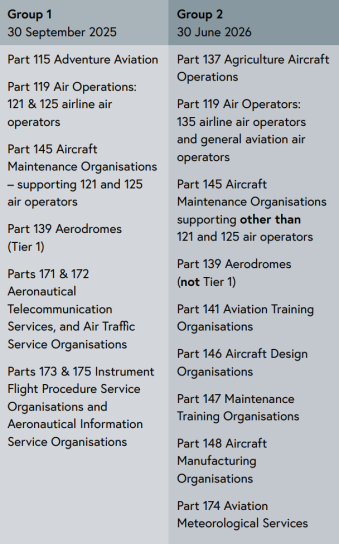The Act will not bring sudden and drastic change on the day it’s introduced. Rather, the Act modernises language, and updates legislation to allow for modern technology. It also introduces changes which will be phased in over time, meaning that on 5 April 2025, business will just continue as usual.
Expositions and operating specifications
Your expositions and operating specifications will remain in place until they’re due for renewal, or until you need them to be amended for some other reason. That’s when they’ll need to be updated to reflect the new Act.
If a certificate or licence renewal falls before 5 April 2025, it will be processed under the 1990 Act. Those received immediately after 5 April 2025 will be processed under the new Act, and we’ll take a pragmatic approach with references to the 1990 Act.
The rules
All 50 existing Parts have been updated to modernise some of the language, remove old transitional rules, and make sure the rules align with the new Act. But the rules themselves are not being rewritten. There are no changes to the intent and meaning of the existing rules, and – apart from some minor exceptions – existing Part numbers stay the same.
The draft rules, and summaries of the changes, are published on our website (see below for the link) so you can see how they’re likely to look from 5 April 2025. You can have a look and let us know if you have any concerns.
Drug and alcohol management plans
The biggest change for some of you is the introduction of random drug and alcohol testing. This will begin after 5 April 2027.
It will affect the employees of about 300 certificated operators, who conduct ‘safety-sensitive activities’. These are activities that could significantly affect the safety of anybody on board an aircraft, or an activity which, if not done safely, could cause or contribute to an aircraft accident.
As part of introducing testing, operators will need to develop drug and alcohol management plans (DAMPs).
The Act allows for these to be submitted to us, here at the CAA, for approval in two phases – the first by 30 September 2025, and the second by 30 June 2026.
The table at the end of this article shows the dates by which the affected operators will need to provide us with their DAMPs for approval.
A new set of rules – Part 99 Drug and Alcohol Management Plans (DAMPs) – and accompanying advisory circular (AC) are on our website.
The rules in Part 99 come into force on the same day as the Act, 5 April 2025, so that operators have time to prepare their DAMP and get ready for testing from 5 April 2027.
See the link to our website at the end of this article, and scan the QR code to see the draft AC.
The AC provides a template and process for developing these plans, to make it as straightforward as possible for operators.
We’ll do a desk-based assessment of your DAMP application (we won’t need to visit your premises). Once your plan is approved, it will become part of your exposition.
We’ll keep you informed
We’re still working on the policies that support the new Act, and how these will be introduced over time. There’s also training for CAA staff alongside that, to make sure they have a shared understanding of the changes and their impact on the sector.
We’ll provide you with more information about provisions in the Act over the coming months, before any changes occur. This will include more information in Vector magazine and in Vector Online.
This table shows the dates by which relevant operators will need to provide us with their plans for approval.
Questions?
If you have questions about the new Act, you can email us at CAACT2023@caa.govt.nz
Top Photo: iStock.com/BrianScantlebury

